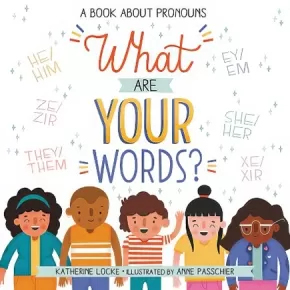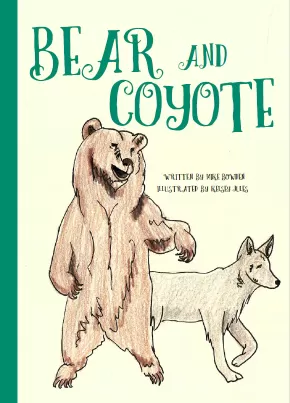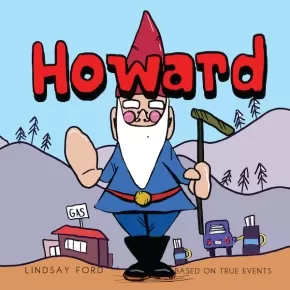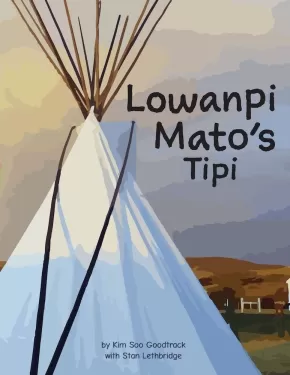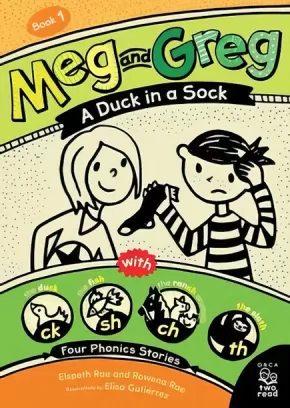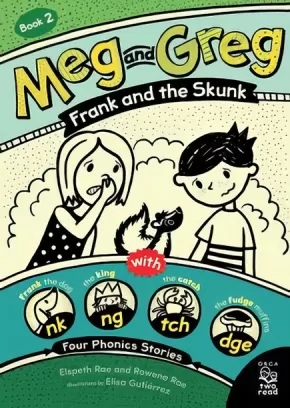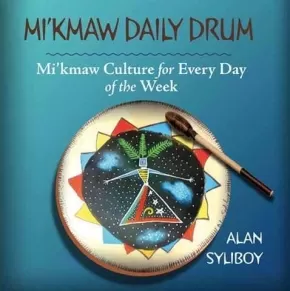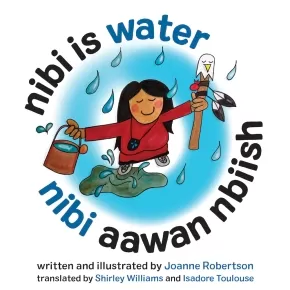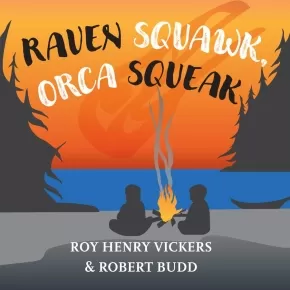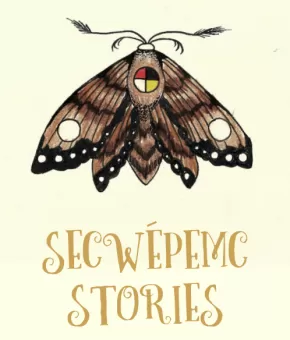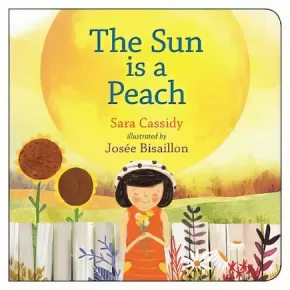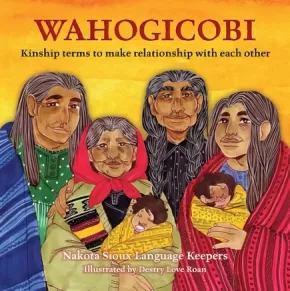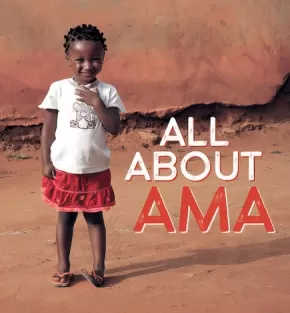
Vocabulary Building
91
-
105
of
127 Results;
Sort By
Go To
of 9
This Is What I've Been Told
$16.99
Artists:
Format:
Paperback
Text Content Territories:
Indigenous Canadian; First Nations; Anishinaabeg; Ojibway;
ISBN / Barcode: 9781989122693
Synopsis:
Synopsis:
Knowing our culture means knowing who we are. When we know who we are, we can walk in a good way.
It's been said when teachings are passed down from one generation to the next, good things can happen. Language is learned, knowledge is shared and culture is practiced. In this story of language preservation, author/illustrator and Anishnaabemowin language teacher Juliana Armstrong illuminates a number of Anishnaabemowin words along with their cultural connections, passed down from her Ojibway ancestors. Knowing our culture means knowing who we are. When we know who we are, we can walk in a good way.
Educator Information
Recommended for ages 6 to 8
This book shares Anishnaabemowin words, their cultural connections and how to say them, with the help of phonetics.
A story of Indigenous language preservation and revitalization.
This authentic book is written and illustrated by an Ojibway artist and Anishnaabemowin language teacher.
A teacher lesson plan is available: This Is What I've Been Told Teacher Lesson Plan
This book is available in French: C'est ce qu'on m'a dit
Additional Information
40 pages | 11.00" x 8.50"
What Are Your Words?: A Book About Pronouns
$22.99
Artists:
Format:
Hardcover
ISBN / Barcode: 9780316542067
Synopsis:
Synopsis:
Follow Ari through their neighborhood as they try to find their words in this sweet, accessible introduction to gender-inclusive pronouns that is perfect for readers of all ages.
Whenever Ari's Uncle Lior comes to visit, they ask Ari one question: "What are your words?" Some days Ari uses she/her. Other days Ari uses he/him. But on the day of the neighborhood's big summer bash, Ari doesn't know what words to use. On the way to the party, Ari and Lior meet lots of neighbors and learn the words each of them use to describe themselves, including pronouns like she/her, he/him, they/them, ey/em, and ze/zir. As Ari tries on different pronouns, they discover that it's okay to not know your words right away—sometimes you have to wait for your words to find you.
Filled with bright, graphic illustrations, this simple and poignant story about finding yourself is the perfect introduction to gender-inclusive pronouns for readers of all ages.
Reviews
"An affirming, conversational picture book that models the ease with which our language can adapt to gender diversity and pronoun use. A recommended first purchase for all libraries."—School Library Journal, starred review
"An affirming, conversational picture book that models the ease with which our language can adapt to gender diversity and pronoun use. A recommended first purchase for all libraries."—School Library Journal, starred review
"Awesome, insightful, powerful, necessary, relevant and woke.... The variety of adjectives used throughout Ari's journey to find their words will delight Language Arts teachers and can serve as a teaching text."—Cicely Lewis, School Library Journal
"Locke's simple narrative...seamlessly incorporates the appropriate pronouns for each person, demonstrating the ease with which language can change to accommodate pronoun diversity.... A sweet, affirming introduction to the language used to communicate a range of gender identities."—Booklist
Educator Information
Recommended for ages 4 to 8.
Recommended for ages 4 to 8.
Additional Information
40 pages | 10.05" x 10.15" | Hardcover
Bear and Coyote (PB)
 $11.95
$11.95

Artists:
Format:
Paperback
Text Content Territories:
Indigenous Canadian; First Nations; Salish; Interior Salish; Secwepemc (Shuswap);
ISBN / Barcode: 9781771745703
Synopsis:
Synopsis:
Kenkéknem (Bear) and Sek̓lép (Coyote) are both busy preparing for the long winter months ahead. Kenkéknem eats berries while Sek̓lép dries salmon and bakes Bannock. They have always done this separately and do not want to share with each other. However, this year Kenkéknem is curious about what Sek̓lép is doing, and he is also very hungry. Kenkéknem curiosity and hunger soon get them both in trouble. This forces them to work and learn together to find out how to solve their problem. In the process, they learn through shared experiences and reflect together. They then discover that they have many new stories to share and new ways to prepare food together.
They gather their relations to share their stories in a wider circle of community in order to share this way of learning through connectedness and relationships.
Bear and Coyote tells the creation story of traditional foods and shows the possibilities that arise when we work together. This book makes for a great bedtime story or read-aloud in the classroom.
The back of the book includes recipes for Bannock (Sp̓ íxle7cw) and Saskatoon Berry Jam (Speqpeq7úw̓l).
Bear and Coyote complements other works by Mike Bowden and Kelsey Jules, including Chief Goose and Porcupine, and includes a familiar character from Four Winds.
Educator & Series Information
Recommended for grades 3 to 7.
This book is part of the Secwépemc Stories series.
This story is a great resource to introduce Indigenous languages to young readers. Secwepemctsín is one of 30 distinct Indigenous languages in British Columbia and is in the process of being revitalized after governments and religions developed policies to eliminate the rich language and culture of Indigenous peoples. The book integrates Secwépemc words into the text and includes a pronunciation guide on every page.
This story connects to the BC First Principles of Learning: learning is holistic, reflexive, experiential, and relational; learning involves the consequences of one’s actions; learning is embedded in story; and learning involves patience and time. Learning from Indigenous stories can be different and personal every time a story is read or told, depending on context. This book provides opportunity for those reading to reflect, explore, connect, and learn on a personal interpretative level.
Curriculum links:
- Social emotional learning: cooperation, working together, reciprocal relationships
- Reading and language skills
- Numeracy: includes recipes and encourages young learners to measure and count ingredients
- Food: gathering, preparing, and cooking traditional foods
- Indigenous knowledge and traditions
Additional Information
24 Pages | Colour illustrations | 22 x 28 cm | ISBN: 9781771745703 | Paperback
Chief Goose (PB)
 $11.95
$11.95

Artists:
Format:
Paperback
Text Content Territories:
Indigenous Canadian; First Nations; Salish; Interior Salish; Secwepemc (Shuswap);
ISBN / Barcode: 9781771745697
Synopsis:
Synopsis:
Kúkwpi7 K̓wsucw (Chief Goose) is the leader of the k̓wsucw (geese). As a leader, he relies on doing things the way his people have always done and does not want to change anything. But his people are not prepared for the long winter and Kúkwpi7 K̓wsucw realizes it is time for him to be a true leader. Following ancient protocols, he first consults the great spirit for guidance and wisdom. Then he begins the journey to lead his people in search for a better place to live during the long winter season. Through trial and error, he learns that listening to others and allowing his people to help him lead is the path to the well-being of the k̓wsucw.
Chief Goose tells the story of why geese fly south for the winter and is the perfect bedtime story or read-aloud for classrooms.
This book complements other works by Mike Bowden and Kelsey Jules, including Four Winds, Porcupine, and Bear and Coyote.
Educator Information
Recommended for grades 3 to 7.
This book is part of the Secwépemc Stories series.
This story is a great resource to introduce Indigenous languages to young readers. Secwepemctsín is one of 30 distinct Indigenous languages in British Columbia and is in the process of being revitalized after governments and religions developed policies to eliminate the rich language and culture of Indigenous peoples. The book integrates Secwépemc words into the text and includes a pronunciation guide on every page.
This story connects to the BC First Peoples’ Principles of Learning: learning is holistic, reflexive, experiential, and relational; learning involves the consequences of one’s actions; learning is embedded in story; and learning involves patience and time. Learning from Indigenous stories can be different and personal every time a story is read or told, depending on context. This book provides an opportunity for those reading to reflect, explore, connect, and learn on a personal interpretative level.
Curriculum links:
- Social emotional learning: leadership, listening, social awareness, learning from mistakes and trying again
- Reading and language skills
- Indigenous knowledge and traditions
Additional Information
24 Pages | Colour illustrations | 22 x 28 cm | ISBN: 9781771745697 | Paperback
Howard
 $18.00
$18.00

Artists:
Format:
Paperback
ISBN / Barcode: 9781775379614
Synopsis:
Synopsis:
Do giants get homesick? What happens when the world’s largest gnome moves from home? A story about being the new kid and for anyone who has moved from home.
Educator & Series Information
Howard – A story about Vancouver Island’s giant gnome that moved from home. How to talk to kids about moving and trying new things? This is a good start. Written in a fun rhyming meter to help develop a child’s reading skills and vocabulary and also keeping their attention as they will want to guess what happens to Howard next.
Part of the Awkward+Awesome children’s book series celebrating unlikely heroes and inner weirdos.
Based on true events.
Suitable for children ages 4-9 and for anyone who experiences change and likes to read.
Additional Information
36 Pages | Paperback
Lowanpi Mato’s Tipi
 $18.50
$18.50

Artists:
Format:
Hardcover
Text Content Territories:
Indigenous Canadian; First Nations; Sioux; Lakota;
ISBN / Barcode: 9781771744751
Synopsis:
Synopsis:
“Hokahe! Welcome!”
Welcome to Wood Mountain, home of the Lakota People, in southern Saskatchewan. It is here that we meet Stan Lethbridge, whose ancestral name is Lowanpi Mato (Singing Bear).
Join Lowanpi Mato as he prepares to set up his summer Tipi. He shares with us Lakota life values and traditions, and how they connect to building and taking care of a Tipi. He teaches us that to build a Tipi you need many items; some are from natural sources and others are purchased from a store. Lowanpi Mato takes us through a step-by-step building process so that we can all learn how a Tipi is built.
The Lakota language is woven throughout the story. The Lakota counting chart on pages 30 and 31 invites you to learn to count and have some fun looking back through the book to find items that match each number.
Welcome to Wood Mountain, home of the Lakota People, in southern Saskatchewan. It is here that we meet Stan Lethbridge, whose ancestral name is Lowanpi Mato (Singing Bear).
Join Lowanpi Mato as he prepares to set up his summer Tipi. He shares with us Lakota life values and traditions, and how they connect to building and taking care of a Tipi. He teaches us that to build a Tipi you need many items; some are from natural sources and others are purchased from a store. Lowanpi Mato takes us through a step-by-step building process so that we can all learn how a Tipi is built.
The Lakota language is woven throughout the story. The Lakota counting chart on pages 30 and 31 invites you to learn to count and have some fun looking back through the book to find items that match each number.
Educator Information
Lakota language is woven throughout this story, as are the seven values of Lakota life.
Lakota language is woven throughout this story, as are the seven values of Lakota life.
Includes a counting chart from 1 to 20 in Lakota, as well as a search-and-find counting game.
Additional Information
32 pages | 8.5" x 11" | Hardcover | ISBN: 9781771744751
32 pages | 8.5" x 11" | Hardcover | ISBN: 9781771744751
Meg and Greg: A Duck in a Sock
$16.95
Artists:
Format:
Paperback
ISBN / Barcode: 9781459824904
Synopsis:
Synopsis:
A Duck in a Sock is the first book in a series designed for shared reading between a child learning to read and an experienced reader. The stories have special features to help a child with dyslexia or another language-based learning difficulty find reading success.
Meg and Greg are hanging out for the summer doing what ten-year-olds do—helping an injured duckling, finding a lost pet fish, saving ranch animals from a wildfire and catching a wandering sloth! Jump inside to join Meg and Greg on their adventures.
Reviews
"My students love the engaging story lines of the Meg and Greg books. Although they are only meant to read the captions on the picture pages, they take great pride in trying (and succeeding!) to read the "teacher pages" as well" - Leslie O'Haga
Educator & Series Information
Recommended for ages 6 to 9.
This book includes features to accommodate struggling or dyslexic readers, such as comic-book-style illustrations, a dyslexia-friendly typeface with ample spacing and shaded paper to reduce contrast between text and paper—all of which make this series more accessible.
Targeted at struggling readers ages six to nine, A Duck in a Sock has a wide appeal to ELL readers, reluctant readers and at-level readers alike with its engaging and age-appropriate plots and low reading level that doesn’t demoralize or stigmatize struggling readers.
Co-author Elspeth Rae is a teacher certified in using the Orton-Gillingham Approach to teach children with dyslexia and other language-based learning difficulties. She is currently a literacy specialist teaching reading, spelling and writing to children ages five to thirteen.
Co-author Elspeth Rae was diagnosed with dyslexia when she was eight years old.
This is the first book in the Meg and Greg series, a new Orca Two Read series for shared reading that introduces one new phonogram (a letter or combination of letters that represent a sound) in each story. These books are cumulative, so each story builds on the previous one, and each book will build on the previous book. The first book covers the ck, sh, ch and th phonograms.
On the left page is an adult or buddy reader's text. On the right is the kid's text on grey paper, a feature that helps readers with dyslexia. Key features include:
- Shaded paper that reduces contrast.
- Labels that allow very early readers to participate.
- Extra space between letters, words and lines of text.
- Kid's text that is controlled to remove spelling exceptions and advanced words.
- Words with target phonogram that appear in bold type.
- Easy to read font.
A downloadable resource pack is available: Resource Pack - Meg and Greg: A Duck in a Sock
Additional Information
168 pages | 5.87" x 8.25"
Meg and Greg: Frank and the Skunk
$16.95
Artists:
Format:
Paperback
ISBN / Barcode: 9781459824935
Synopsis:
Synopsis:
Frank and the Skunk is the second book in the Orca Two Read line designed for shared reading between a child learning to read or struggling to read and an experienced reader, following Duck in a Sock. The stories have special features to help a child with dyslexia or another language-based learning difficulty find reading success.
Besties Meg and Greg are off to sleep-away camp for the summer! Along with your standard camp activities (swimming and making crafts) the duo have a run-in with a skunk, sing a silly song about a king, go on a canoe trip that has one glitch after another, and make a mess in the lodge with a fresh batch of fudge! So sit down and cozy up for another set of Meg and Greg adventures, this one focusing on the phonograms: nk, ng, tch and edge.
Educator Information
Recommended for ages 6 to 8.
This book is part of the Meg and Greg Series, an Orca Two Read line designed for shared reading between a child learning to read or struggling to read and an experienced reader.
Themes: phonics, dyslexia, learning difference, animal adventures, buddy reading
A downloadable resource pack is available: Resource Pack - Meg and Greg: Frank and the Skunk
Additional Information
160 pages | 5.87" x 8.25" | b&w illustrations
Mi'kmaw Daily Drum: Mi'kmaw Culture for Every Day of the Week (BB)
$14.95
Artists:
Format:
Board Book
Text Content Territories:
Indigenous Canadian; First Nations; Mi'kmaq;
Grade Levels: Preschool;
ISBN / Barcode: 9781771088893
Synopsis:
Synopsis:
A baby board book from the bestselling artist behind Mi'kmaw Animals that teaches young readers Mi'kmaw concepts and a Mi'kmaw word for each day of the week.
From celebrated artist Alan Syliboy, this vital book for the youngest readers showcases seven of Syliboy’s popular Daily Drum artworks, each paired with a different day of the week. From Spirit Woman to Caribou to Round Dance, Mi’kmaw culture and teachings are offered up to newborns and toddlers in a vibrant and accessible book.
Educator Information
Recommended for ages 3 and under.
Includes references to Muin, the eight-point star, the round dance, and Spirit Woman.
Additional Information
10 pages | 7.00" x 7.00" | Boardbook
Nibi is Water (BB)
$12.95
Artists:
Format:
Board Book
Text Content Territories:
Indigenous Canadian; First Nations; Anishinaabeg; Ojibway;
Grade Levels: Preschool;
ISBN / Barcode: 9781772601329
Synopsis:
Synopsis:
Nibi is water and water is life.
A first conversation about the importance of Nibi—which means water in Anishinaabemowin (Ojibwe)—and our role to thank, respect, love, and protect it. Babies and toddlers can follow Nibi as it rains and snows, splashes or rows, drips and sips. Written from an Anishinaabe water protector’s perspective, the book is in dual language—English and Anishinaabemowin (Ojibwe).
Educator Information
Board Book for ages 0 - 3 / Preschool.
A board book for babies and toddlers that introduces the importance of water and water protection. Indigenous water protectors, like author Joanne Robertson, are highly respected environmentalists in Canada and across North America. Joanne Robertson is the author and illustrator of the award-winning picture book The Water Walker.
Dual-language: Anishinaabemowin (Ojibwe) and English. Dual-language books are important in all of our efforts to support the Truth and Reconciliation Commission of Canada's Call to Action, specifically the call to promote, support, and teach Indigenous languages.
Subjects: Character Education (Strong Female Role Models); Environmentalism; History & Social Studies (Canadian History, First Nations & Indigenous Peoples, Social Justice).
Translated by Shirley Williams and Isadore Toulouse.
Additional Information
28 pages | 7.00" x 7.00"
Raven Squawk, Orca Squeak (BB)
$12.95
Format:
Board Book
Text Content Territories:
Indigenous Canadian;
Grade Levels: Preschool;
ISBN / Barcode: 9781550179040
Synopsis:
Synopsis:
With bright and bold illustrations by celebrated Indigenous artist Roy Henry Vickers, this sturdy board book introduces iconic sounds of the West Coast and supports the language development of babies and toddlers. From the the crackle of a beach campfire to the swoosh of canoe paddles, the rustle and creak of cedars in the wind, the roar of sea lions and the crashing waves of the Pacific Ocean, the rhythmic text, vibrant illustrations and glossy tactile finish of Raven Squawk, Orca Squeak will delight the very youngest readers.
Educator & Series Information
Recommended for ages 3 and under.
This book is part of the First West Coast Books series.
Additional Information
20 pages | 6.00" x 6.00"
Secwépemc Stories Bundle
 $48.92 $54.35
$48.92 $54.35

Text Content Territories:
Indigenous Canadian; First Nations; Salish; Interior Salish; Secwepemc (Shuswap);
ISBN / Barcode: 9781771746632
Synopsis:
Synopsis:
This bundle includes all four Secwépemc stories from Mike Bowden:
- Four Winds (hardcover)
- Porcupine (paperback)
- Bear and Coyote (paperback)
- Chief Goose (paperback)
Secwépemc Stories are the collaborative work of Secwépemc author Mike Bowden and Secwépemc artist Kelsey Jules. These stories convey Secwépemc teachings and embody Indigenous ways of knowing. Mike, a storyteller and educator, strongly believes in story as a way of learning and understanding the world and our relationships within it. Secwépemc language is integrated into the stories and accompanied by pronunciation guides.
These stories connect to the BC First Peoples principles of learning and provide opportunities for those reading to reflect, explore, connect and learn on a personal interpretative level.
Additional Information
Books are 8.5" x 11" | 24 Pages | ISBN 9781771746632
Scroll below to learn more about each book included.
The Sun is a Peach (BB)
$10.95
Artists:
Format:
Board Book
Grade Levels: Preschool;
ISBN / Barcode: 9781459818675
Synopsis:
Synopsis:
What does the sun look like to you?
A young child walks along a country road into town where there’s a parade on. The experiences of the day, and the child’s eventual homecoming and bedtime, are chronicled and compared to the sun. The sun takes the form of the yolk of an egg, a spool of thread, the eye of a bird, an ice-cream cone and a dandelion. Each round, yellow item on the page hints at the big golden ball in the sky.
Stunning illustrations by Josée Bisaillon capture how imagination shapes the environment around us. This simple board book shows children that the way they see the world—by heart, mind and imagination—is just right. Revelling in metaphor, The Sun is a Peach encourages that magical leap of imagination and asks the reader to look at everyday objects from a different perspective.
Educator Information
Boardbook for ages 2 and under.
This is the companion title to The Moon is a Silver Pond.
In this book a young child learns about metaphor, comparing their observations of the sun to other everyday objects they encounter through their day from dawn to dusk.
Themes / Topics: learning about metaphor, figuartive language, observation, point of view, child's perspective, bedtime stories, concepts, size and shape, the sun.
This resource is available in French as a hardcover book: Le soleil est une pêche
Additional Information
24 pages | 7.00" x 7.00"
24 pages | 7.00" x 7.00"
Wahogicobi: Kinship terms to make relationship with each other (BB)
$7.95
Artists:
Format:
Board Book
Text Content Territories:
Indigenous Canadian; First Nations; Stoney-Nakoda (Nakota); Alexis Nakota Sioux Nation;
ISBN / Barcode: 9781926696867
Synopsis:
Synopsis:
Our Aboriginal Elders tell of a time when animals and humans could speak to each other. When humans became too greedy and killed more animals than they needed for food, the Creator changed that relationship to protect the animals. So the Creator made a Spirit Animal to represent each one and granted them gifts they could give to people.
Spirit Animals teach, heal and inspire. Turtle carries North America on its back and symbolizes peace and balance. Bear is called “Grandfather” for its strength, leadership, confidence and courage. Coyote gifted us with fire and knowledge of herbs and food. Wolf taught us to hunt and form communities.
This book is a guide, and the meanings of the Spirit Animals featured here are only one interpretation. If you see these Spirit Animals or Totems reflected in your own life, you have received their gift.
Educator Information
Encourages learning of simple kinship phrases in English and Nakota Sioux.
Additional Information
24 pages | 6.99" x 6.99" | Board Book
All about Ama - Nunavummi Reading Series
$7.95
Format:
Paperback
ISBN / Barcode: 9780228702351
Synopsis:
Synopsis:
Meet Ama!
This book introduces readers to simple vocabulary for parts of their body, such as eyes, ears, and arms.
Educator & Series Information
This book is part of the Nunavummi Reading Series, a Nunavut-developed series that supports literacy learning while teaching readers about the people, traditions, and environment of the Canadian Arctic. The Nunavummi Reading Series is now offering books that explore a global perspective. This is one of those books, focusing on the daily life of people in Ghana, West Africa.
This book is a level 5 book in the Nunavummi Reading Series.
Nunavummi Reading Series books have also been officially levelled using the Fountas & Pinnell Text Level Gradient™ Levelling System. This book's F&P level: B.
Curriculum Connections: Language and Literacy; Diversity; Identity
Recommended for ages 5-7.
Additional Information
20 pages | 6.50" x 7.00"
Sort By
Go To
of 9




